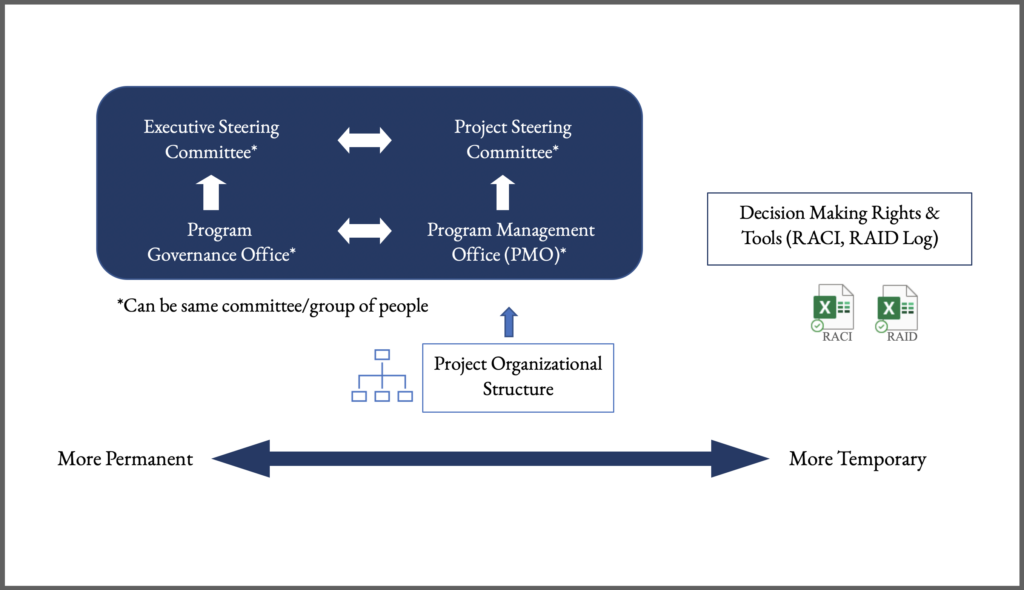Welcome to the final post in our 4-part blog series on program and project governance. In the first and second parts of our series, we discussed the differences between programs and projects, along with some of the key considerations when setting up program and project governance in your organization. In the third part, we reviewed the committees, bodies, and structures that are part of successful governance. Today, we will go over decision-making rights and tools to ensure the success of your IS programs and projects:
- Decision-making Rights & Tools
- Stakeholder Decision-making Matrix
- RACI
- RAID Log
- Reporting & Status Management

Decision-making Rights and Tools
According to the Deloitte article “Getting Decision Rights Right“, ambiguity surrounding who is responsible for making a decision or decisions is a primary cause of delay in the decision-making process. Confusion about who makes which decisions and how they are made can increase the risk that some decisions will simply fall through the cracks entirely. Research shows that top-performing companies define roles, responsibilities, and process:
- Simplify and clarify decision rights across the organization
- Are transparent about expectations of accountability for decision makers
- Align individuals in decision-making groups that work toward a common mission
Decision-making influences overall company performance, so it is critical for organizations to set clear roles and responsibilities. This clarity leaves little room for confusion, wasted resources, or lack of accountability. As process is established, consider these key objectives: (1) Give all those involved a sense of ownership over their decisions, and (2) Identify where individuals are best suited within the process–who should provide input, who should follow through, and who should ultimately be responsible for making key decisions in defined areas of the organization.
Key considerations for your organization before you start a program or project:
- Who are the individuals or groups empowered to make decisions?
- What decisions must be made and what is the timeline?
- Who is responsible for deciding? Who will execute the work?
- Who is accountable for the decision’s outcomes?
- Who should be consulted for input, information, and insight?
- Who should be informed about the decision and its outcome?
- Each decision should have only one decider with single point of accountability.
Stakeholder Decision-making Matrix
A stakeholder decision-making matrix is a tool used to define and communicate who has ownership and who is responsible for the business processes, systems, and data that are part of a program and/or project scope. It can be used to reduce conflict and/or confusion on who should review and approve strategic and tactical decisions.
RACI Chart
- A RACI chart is a simple diagram used in project management to map task-level roles and responsibilities.
- A RACI chart defines whether the people involved in a project activity will be responsible, accountable, consulted, or informed for the corresponding task, milestone, or decision.

RAID Log 
- RAID is an acronym that stands for Risks, Actions, Issues and Decisions, and the log tracks all of those items within a project.
- Using a RAID log enables project managers and teams to follow a consistent approach to project delivery.
- The RAID log records information such as cause, probability, impact, mitigation, owner, etc. for things that could go wrong but have not yet occurred.
And that brings us to reporting & status management. This topic deserves it owns blog series, so watch for our coverage of it in the future.
In conclusion, by investing in your organization’s approach to decision-making rights and tools, you increase the chance of successfully achieving the objectives of your IS programs and projects. We hope you found the information in this blog series to be valuable. Reach out to us with other questions or to talk staffing support for your organization in 2024 and beyond.
Here are links to all other blog posts in this governance series: Part I: Understanding Programs vs. Projects | Part II: Defining Rules, Procedures, and Policies | Part III: Defining Committees, Bodies, and Structures





